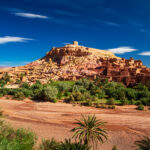Who Are the Gnawa?
The Gnawa people come from black Africans who were forcibly brought to Morocco. They were taken from sub-Saharan regions like Sudan, Mali, and Niger. These individuals suffered as victims of the trans-Saharan slave trade. This dark period in history saw many Africans captured and sold as slaves. They endured long and harsh journeys across the Sahara Desert, often chained together. To cope with their suffering, they sang rhythmic chants. These chants provided comfort and became a vital part of their cultural identity. Over time, this music evolved into what we now call Gnawa music. It expresses the Gnawa people’s heritage, spirituality, and strength.
Slavery in Morocco
Slavery played a significant role in shaping Morocco’s history. Enslaved people built many of the country’s grand kasbahs, including the famous Telouet Kasbah in the High Atlas Mountains. The trade of gold, salt, and slaves generated wealth that contributed to constructing these powerful structures. For example, at Telouet, traders valued a kilogram of gold equally to a kilogram of salt and two slaves.
During this period, Sijilmasa, now known as Rissani, served as a major trade hub. This town was a vital stop on the trans-Saharan trade route. Many slaves worked there as shepherds and servants. Despite the rise of Islam in Morocco in the 11th century, which forbids slavery, the practice continued until the 18th century. Only then did slaves in regions like Sijilmasa gain their freedom.
Even after gaining their freedom, the former slaves kept their cultural practices alive, including their music. They continued creating instruments like the Guembri and Hajhuj using materials available in their environment. Goat intestines, skin, and wood from desert trees provided the needed resources. Their music, once a reflection of suffering, transformed into a celebration of freedom and a deep expression of their spiritual beliefs.
Khamlia Village
Khamlia is a small village in the Moroccan Sahara. It is home to the descendants of the Gnawa people. Despite its modest size, Khamlia holds immense cultural significance. The village is often called the “Gnawa village” because its people have preserved their traditions and passed them down through generations.
For many years, the Gnawa lived as nomads, moving from place to place in search of food and safety. They finally settled in Khamlia in the last century. Today, around 390 people live in the village, all deeply connected to their Gnawa heritage. The music, traditions, and customs of the Gnawa people remain vibrant in Khamlia. This makes it a unique and culturally rich community.
Location of Khamlia Village
Khamlia lies just 7 kilometers south of Merzouga, at the gateway to the Sahara Desert. Despite its proximity to Merzouga, a popular destination for tourists seeking desert adventures, Khamlia remained largely unknown until recently. The construction of a road through the village in 2004 connected it more directly to the outside world. This brought tourists eager to experience the Gnawa people’s culture.
The village’s location at the edge of the desert gives it a unique and picturesque setting. Surrounded by vast dunes and open skies, Khamlia offers visitors a glimpse into the simple yet profound life of the Gnawa people.
The Story of Khamlia Village
Khamlia’s history is deeply connected to the broader history of slavery in Morocco. The ancestors of the current inhabitants of Khamlia were brought to Morocco as slaves. However, they never lost their connection to their homeland or their cultural practices. Over time, they built a community in Khamlia where they could live freely and openly practice their traditions.
In Khamlia, Gnawa music goes beyond entertainment; it is a way of life. The music, rooted in their ancestors’ suffering, has evolved into a celebration of freedom and gratitude. It serves as a spiritual experience that connects the people of Khamlia to their past while also giving them a sense of pride and identity in the present.
History of Khamlia Gnawa Festival

One of the most significant cultural events in Khamlia is the annual Khamlia Gnawa Festival, known as Sadaka. This festival celebrates Gnawa culture and serves as a time for the community to come together in gratitude and spiritual reflection.
In the past, 3 music groups in Khamlia would perform at each of the village houses once a year. This allowed them to collect donations of basic provisions like flour, sugar, tea, or money. These donations funded the festival, which took place every summer. The festival allowed the villagers to celebrate their heritage, share their music with others, and strengthen the bonds within their community.
However, in 2011, an Imam arrived in the village and attempted to divide the people by claiming that their music was prohibited under Sharia law. This caused confusion and division within the community. Some villagers continued to support the music, while others did not. As a result, the traditional house performances became less common, and villagers no longer knew which houses would welcome these personal performances.
To address this issue, the community created a charity to provide a space for the pre-festival fundraising performances. This also allowed tourists to participate more fully in the festival. Today, the Sadaka festival remains a significant event in Khamlia. It attracts hundreds of attendees, including Gnawa from all over Morocco. For three days and nights, the Gnawa play their music non-stop in an incessant, trance-like rhythm. The music is believed to have healing properties, and the festival provides a time to seek divine blessings and celebrate the common heritage of the Gnawa people.
Conclusion
Khamlia may be a small village in the Moroccan Sahara, but its story speaks of resilience, cultural preservation, and the transformative power of music. The Gnawa people, with their rich history and deep connection to their music, have turned a painful past into a celebration of freedom and gratitude. Visitors to Khamlia have the opportunity to experience this unique culture firsthand, to hear the rhythms of the desert, and to connect with a community that has kept its traditions alive against all odds.











